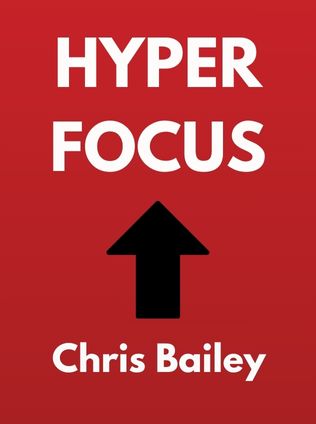
Hyperfocus
How to Be More Productive in a World of Distraction
By Chris Bailey
Published 08/2018
About the Author
Chris Bailey is a noted productivity expert, speaker, and author, renowned for his in-depth exploration of the science of productivity. His interest in productivity began during his university years, leading him to undertake a year-long experiment after graduation where he tried out various productivity techniques and documented their effects on his life. This experiment formed the basis for his first book, "The Productivity Project," which was widely praised for its practical advice and engaging style. Bailey's work focuses on helping individuals and organizations achieve more by managing their attention effectively. In "Hyperfocus," Bailey delves into the nuances of attention management, arguing that in a world full of distractions, the ability to control where and how we focus is the key to productivity and creativity.
Main Idea
"Hyperfocus" by Chris Bailey challenges the conventional wisdom that productivity is all about time management. Instead, Bailey asserts that true productivity stems from how well we manage our attention. The book introduces two primary methods of attention management: hyperfocus, which is about maximizing productivity by intensely focusing on one task at a time, and scatterfocus, which is about fostering creativity through deliberate mind-wandering. By mastering these two states of attention, Bailey argues that we can enhance both our efficiency and our creative potential, leading to greater personal and professional fulfillment.
Table of Contents
- Introduction
- Understanding Attention
- Hyperfocus: The Key to Productivity
- Scatterfocus: The Key to Creativity
- Practical Strategies for Hyperfocus
- Practical Strategies for Scatterfocus
- Combining Hyperfocus and Scatterfocus
- Conclusion
Understanding Attention
Bailey begins by discussing the concept of attention and its central role in determining our productivity and creativity. He argues that while time is a finite resource, attention is something we can control and optimize. By learning to direct our attention deliberately, we can achieve more meaningful and impactful work. Bailey introduces the "attention management matrix," a tool that helps categorize tasks based on their level of productivity and enjoyment. This matrix allows individuals to see where their attention typically goes and make more informed decisions about where to focus it moving forward.
The matrix is divided into four quadrants:
- Quadrant 1: Unproductive and unenjoyable tasks, which should be minimized or eliminated.
- Quadrant 2: Enjoyable but unproductive tasks, which can serve as distractions.
- Quadrant 3: Necessary but unenjoyable tasks, which require focus but may not be fulfilling.
- Quadrant 4: Both productive and enjoyable tasks, which are the most valuable and should be prioritized.
Bailey emphasizes that most people spend too much time in Quadrants 1 and 2, reacting to external triggers and distractions. By shifting more attention to Quadrants 3 and 4, individuals can focus on tasks that align with their goals and values, ultimately leading to greater productivity and satisfaction.
Sign up for FREE and get access to 1,400+ books summaries.
You May Also Like
The Subtle Art of Not Giving a F*ck
A Counterintuitive Approach to Living a Good Life
By Mark MansonRich Dad Poor Dad
What the Rich Teach Their Kids About Money - That the Poor and Middle Class Do Not!
By Robert T. KiyosakiHow To Win Friends and Influence People
The All-Time Classic Manual Of People Skills
By Dale CarnegieFreakonomics
A Rogue Economist Explores the Hidden Side of Everything
By Steven D. Levitt and Stephen J. Dubner



















